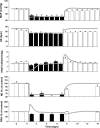Lowering of blood pressure by chronic suppression of central sympathetic outflow: insight from prolonged baroreflex activation
- PMID: 22797307
- PMCID: PMC3524662
- DOI: 10.1152/japplphysiol.00552.2012
Lowering of blood pressure by chronic suppression of central sympathetic outflow: insight from prolonged baroreflex activation
Abstract
Device-based therapy for resistant hypertension by electrical activation of the carotid baroreflex is currently undergoing active clinical investigation, and initial findings from clinical trials have been published. The purpose of this mini-review is to summarize the experimental studies that have provided a conceptual understanding of the mechanisms that account for the long-term lowering of arterial pressure with baroreflex activation. The well established mechanisms mediating the role of the baroreflex in short-term regulation of arterial pressure by rapid changes in peripheral resistance and cardiac function are often extended to long-term pressure control, and the more sluggish actions of the baroreflex on renal excretory function are often not taken into consideration. However, because clinical, experimental, and theoretical evidence indicates that the kidneys play a dominant role in long-term control of arterial pressure, this review focuses on the mechanisms that link baroreflex-mediated reductions in central sympathetic outflow with increases in renal excretory function that lead to sustained reductions in arterial pressure.
Figures




Similar articles
-
Electrical carotid sinus stimulation in treatment resistant arterial hypertension.Auton Neurosci. 2012 Dec 24;172(1-2):31-6. doi: 10.1016/j.autneu.2012.10.009. Epub 2012 Nov 9. Auton Neurosci. 2012. PMID: 23146623 Review.
-
Chronic activation of the baroreflex and the promise for hypertension therapy.Handb Clin Neurol. 2013;117:395-406. doi: 10.1016/B978-0-444-53491-0.00032-8. Handb Clin Neurol. 2013. PMID: 24095142 Review.
-
Role of the heart in blood pressure lowering during chronic baroreflex activation: insight from an in silico analysis.Am J Physiol Heart Circ Physiol. 2018 Nov 1;315(5):H1368-H1382. doi: 10.1152/ajpheart.00302.2018. Epub 2018 Jul 13. Am J Physiol Heart Circ Physiol. 2018. PMID: 30004810 Free PMC article.
-
Lowering of blood pressure during chronic suppression of central sympathetic outflow: insight from computer simulations.Clin Exp Pharmacol Physiol. 2010 Feb;37(2):e24-33. doi: 10.1111/j.1440-1681.2009.05291.x. Epub 2009 Sep 21. Clin Exp Pharmacol Physiol. 2010. PMID: 19769610 Free PMC article.
-
Carotid baroreceptor stimulation, sympathetic activity, baroreflex function, and blood pressure in hypertensive patients.Hypertension. 2010 Mar;55(3):619-26. doi: 10.1161/HYPERTENSIONAHA.109.140665. Epub 2010 Jan 25. Hypertension. 2010. PMID: 20101001 Clinical Trial.
Cited by
-
Prolonged Baroreflex Activation Abolishes Salt-Induced Hypertension After Reductions in Kidney Mass.Hypertension. 2016 Dec;68(6):1400-1406. doi: 10.1161/HYPERTENSIONAHA.116.08293. Epub 2016 Oct 24. Hypertension. 2016. PMID: 27777356 Free PMC article.
-
The baroreflex as a long-term controller of arterial pressure.Physiology (Bethesda). 2015 Mar;30(2):148-58. doi: 10.1152/physiol.00035.2014. Physiology (Bethesda). 2015. PMID: 25729060 Free PMC article. Review.
-
Renal denervation for the treatment of resistant hypertension: review and clinical perspective.Am J Physiol Renal Physiol. 2015 Oct 1;309(7):F583-94. doi: 10.1152/ajprenal.00246.2015. Epub 2015 Jul 29. Am J Physiol Renal Physiol. 2015. PMID: 26224718 Free PMC article. Review.
-
Sleep fragmentation exacerbates myocardial ischemia‒reperfusion injury by promoting copper overload in cardiomyocytes.Nat Commun. 2024 May 7;15(1):3834. doi: 10.1038/s41467-024-48227-y. Nat Commun. 2024. PMID: 38714741 Free PMC article.
-
The sympathetic nervous system in obesity hypertension.Curr Hypertens Rep. 2013 Aug;15(4):409-16. doi: 10.1007/s11906-013-0356-1. Curr Hypertens Rep. 2013. PMID: 23677623 Free PMC article. Review.
References
-
- Bie P. Blood volume, blood pressure and total body sodium: internal signalling and output control. Acta Physiol (Oxf) 195: 187–196, 2009. - PubMed
-
- Bisognano JD, Bakris G, Nadim MK, Sanchez L, Kroon AA, Schafer J, de Leeuw PW, Sica DA. Baroreflex activation therapy lowers blood pressure in patients with resistant hypertension: results from the double-blind, randomized, placebo-controlled Rheos Pivotal trial. J Am Coll Cardiol 58: 765–773, 2011. - PubMed
-
- Calhoun DA, Jones D, Textor S, Goff DC, Murphy TP, Toto RD, White A, Cushman WC, White W, Sica A, Ferdinand K, Giles TD, Falkner B, Carey RM. Resistant hypertension diagnosis evaluation, treatment: a scientific statement from the American Heart Association Professional Education Committee of the Council for High Blood Pressure Research. Hypertension 51: 1403–1419, 2008. - PubMed
-
- Chapleau MW, Hajduczok G, Abboud FM. Resetting of the arterial baroreflex: peripheral and central mechanisms. In: Reflex Control of the Circulation, edited by Zucker IH, Gilmore JP. Boca Raton, FL: CRC, 1991, p. 165–194.
-
- Cowley AW., Jr Long-term control of arterial pressure. Physiol Rev 72: 231–300, 1992. - PubMed
Publication types
MeSH terms
Substances
Grants and funding
LinkOut - more resources
Full Text Sources
Medical

